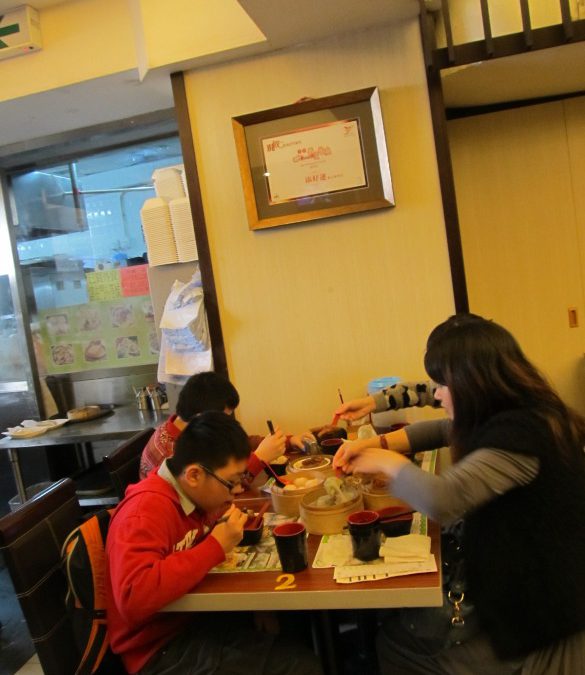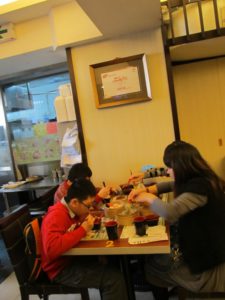DAY 2–Locals say it would take 50 years to sample all the restaurants in Hong Kong.
I’ve only got a few days and I’m determined to eat my way through this huge city.
Today, I’m the only Caucasian face in the jam-packed Tim Ho Wan that has the reputation for being the cheapest Michelin star restaurant in the world. People come here for Dim Sum and are lined up waiting outside.
“We don’t like to make reservations in Hong Kong,” says my guide Wing Lau, who grew up in Hong Kong and has lived here her entire life. “Waiting is part of the experience. “We chat.”
This simple place with the paper placemats and a plastic jug of tea on the table and waiters rushing with the baked buns with BBQ pork that this place is famous for, the steamed fresh shrimp and pork dumplings, the noodles.. I learn only later that is a hot meal ticket because of the chef and the Michelin star.
There are tables of multigenerational families and tables of friends. This isn’t a place to linger—“We eat and we go,” says Lau.
She also says Dim Sum is something natives can’t live without and can’t really cook at home. Take the Glue rice dumpling—rice filled with shrimp, chicken and pork and then wrapped in a leaf and steamed. Delicious! There is a homemade “rice roll” that melts on the tongue but my favorite is the baked BBQ bun—so fresh, salty and sweet at once.
Everyone shares everything. We have tonic medlar and petal—kind of an orange yellow with seeds that I’m told are good for the eyes. This place serves Dim Sum from 8 a.m. until 10 p.m. and is always busy – and incredibly cheap—the two of us eat until we can’t eat anymore for $14.
Later for lunch and dinner we sample diametrically different Hong Kong culinary experiences. For lunch, we head to a historic Chinese Heritage Building in Hong Kong that has been transformed from a turn of the century pawn shop to an oh-so-hip British restaurant called of course The Pawn where the menu changes daily and we feast on oysters flown in from Scotland, whole roast Dover sole with tarragon and dill breadcrumbs, honey glazed carrots and yummy fries with garlic mayo and finished with sticky toffee pudding and ice cream. Yummy and so very British though the crowd was mostly Asian.
For dinner, we took a culinary journey to Shanghai and one of Hong Kong’s most famous Shanghai style restaurants Xiao Nan Guo Premier (high up in a building on the Kowloon side) where we feast on three different kinds of soup (hot and sour, fish soup, steamed pork dumplings) that melt in your mouth, sweet and sour spareribs, pickled cucumber drunken chicken served cold and marinated in sweet Chinese rice wine work fried huge prawns…spring rolls, wok fried rice cake…each was elegantly displayed and oh-so-good.
When people say they eat their way across Hong Kong, I understand it now. I ask our guide Wing Lau, if the Chinese tourists—millions every month–opt for Western cuisine but she says not typically, in part because they don’t have the patience for long drawn out meals. “They’ll eat nine courses in an hour and a half,” she jokes.
Though still jet lagged after the 15-hour flight, I’m trying to get a sense of this amazing place—7 million people living in an area roughly half the size of Rhode Island packed with every variety of store and restaurants.
Green space in this crowded city is prized. We go to Nan Lian Garden in which I learn every hill, rock body of water, plant and timber structure was placed according to the methods of the ancient style of the Tang dynasty. “We don’t have too many gardens,” she notes. “We do our gathering in shopping malls or restaurants.”
There is the famous Chi Lin Nunnery—the largest timber structure in the world where some 80 Taoist nuns live quietly out of public view.
Hollywood Road where you can spend a few dollars on a souvenir or tens of thousands on antiques from dating back to ancient Chinese dynasties (I especially loved the huge stone camel in one of the shop windows). Take your pick of giant Buddhas and tiny dragons, mahjong sets, old photographs and posters of Mao, large Urns and small delicately painted plates.
Are they real antiques? Only an expert can tell. Certainly not me.
We stop in the famous Man Mo Temple where I light incense and make a wish for my family’s good health and good luck this year—as are many other locals. The Man Mo Temple is dedicated to the two gods—King Emperor Man and Holy King Emperor Kwan who are believed to protect the well being of men. The temple is the largest of its kind in Hong Kong and dates balk it is believed to the nineteenth century.
We stop in and meet Harvard MBA Andrea Chung at her Leaf Tea Boutique in the idle of a busy Hong Kong street. Believe it or not in tea drinking Asia, this is the first tea bar in Hong Kong with teas from Africa, India, an d of course China—more than 40 from around the world.
Who knew it was as much about the tea master as the tea. “A lot of these teas people have never heard from,” Chung says.
We sample delicate Snow Dragon green tea and Earl Gray that tastes different than any I’ve ever had (Chang says she tried 30 different samples before she chose this particular one. “I had people sending me samples from around the world,” she said.
Are you cold blooded or warm blooded? If you are warm blooded, it’s good two know that green tea—like the delectable Snow Dragon—has a cooling effect while Black Teas have warming effect. “With the same leaf, different tea masters can create a different flavor.”
We taste White Peony which is very popular in West China and Roselle which is said to be good for weight loss. I buy some for friend who always frets about her weight.. Roselle makes excellent iced tea with sparkling water.
I don’t think I’ll look at a tea bag again the same way.


